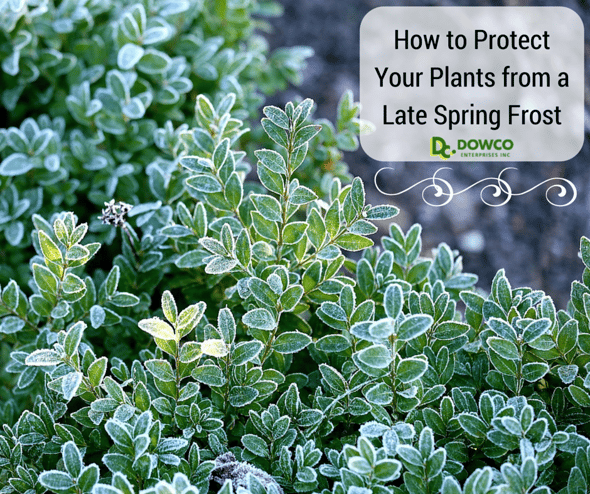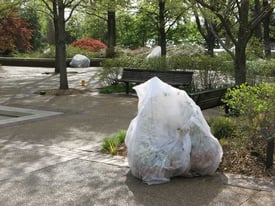“OMG – Did you hear what Dave Murray said about temperatures tonight!”
This time of year is one of the most exciting to me. The bulbs are pushing through the freshly thawed earth, buds on woody plants are swelling with the promise of vibrant fresh color, and Mother Nature is exerting her fickle hand on the weather.

Living in the St. Louis area, we should be used to 40 and 50 degree temperature swings in 24 hours. It doesn’t make it any easier for us gardeners. It’s important to know how to protect plants from frost if we get an unexpected chill in late spring.
What Plants Do During the Spring Season
When plants get their sap flowing at this time of year, chemical changes are happening beneath the surface to make their tissues more susceptible to freezing. It’s like their anti-freeze was diluted with sugary food. If it’s just budding, with no fresh leaves showing, a light frost won’t do damage. However, if there are fresh leaves or petals showing, they could be blackened by even a moderate frost.
The Big Difference Between a Frost and a Freeze
Most frosts are not going to do long term, irreparable damage. Usually it’s just a puckered, darkened edge around the first leaves to emerge or the same with the tips of new flowers.
The real killer is a hard freeze at this time of year. In March of 2011, I believe, we had one of those big swings in temperature and it killed entire branches of woody plants, with some killed entirely.
How to Protect Plants from Frost in Late Spring
 There are several ways to prevent damage when a freeze/frost is predicted. Using a breathable row cover or fabric, such as a sheet, works well. The most important thing is to secure the fabric to the ground around the edges if possible. This traps some of the ground heat and moderates the temperature beneath the cover.
There are several ways to prevent damage when a freeze/frost is predicted. Using a breathable row cover or fabric, such as a sheet, works well. The most important thing is to secure the fabric to the ground around the edges if possible. This traps some of the ground heat and moderates the temperature beneath the cover.
Another method used by many nurseries is to turn on their sprinklers before dawn to melt off the frost and protect the foliage with a thin layer of ice. The effectiveness of this method depends on the plants in question. If they were just shipped from a warmer locale, it’s best to cover them because they are not acclimated to our weather yet. For plants in your garden, this can work well – If you’re willing to get up before dawn and drag a hose around!
Another method we’ve all seen in the spring, on the news, is when the local orchard or strawberry grower is out employing smoke and wind at their facility to prevent damage. When the air is moving, it’s harder for the frost to form, and the smoke makes the air denser, and harder for the cold air mass to penetrate. Some of these operations have extensive systems of large fans and smudge pots to prevent losing their entire crop to one bad night.
Dowco Can Help!
 If Mother Nature decides to throw us a curve, now you know how to protect plants from frost and you can use these methods to minimize the damage. But if you do receive freeze damage to your landscape, Dowco’s team of field techs can selectively remove these areas with selective pruning to leave them looking sharp again.
If Mother Nature decides to throw us a curve, now you know how to protect plants from frost and you can use these methods to minimize the damage. But if you do receive freeze damage to your landscape, Dowco’s team of field techs can selectively remove these areas with selective pruning to leave them looking sharp again.
Related Articles:
6 tips to prevent winter burn on trees and shrubs
When is the right time to trim and prune my shrubs?
Winter burn in St. Louis plants
Interested in hearing from Dowco about your landscape? Contact us today!



